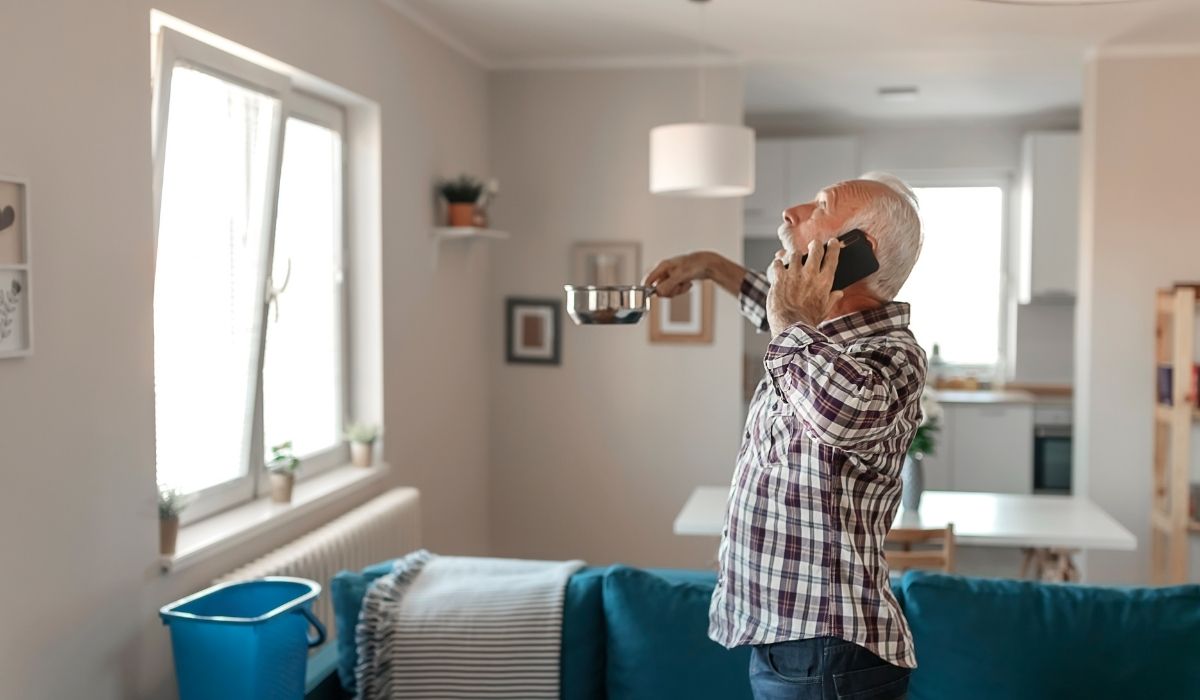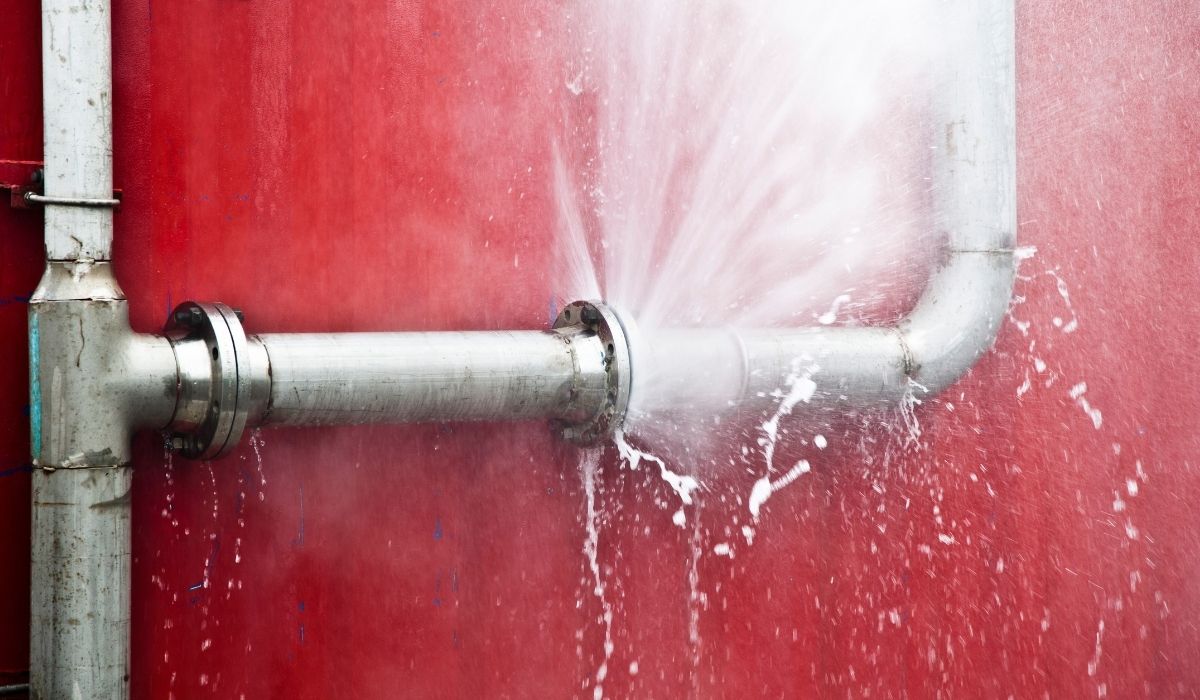Urgent Situations That Require Water Damage Services

When Should You Call Emergency Water Damage Services?
The rapid onset of water damage in a home or commercial property can quickly escalate into an emergency, affecting not only structural integrity but also the health and safety of occupants. Homeowners often face issues caused by burst pipes, appliance malfunctions, or severe weather events that lead to large-scale water intrusion. In these instances, knowing when to contact professional water damage restoration services is critical. Delaying professional intervention can result in further deterioration—including mold growth, contamination by sewage or bacteria, and damage to furniture, wood flooring, and drywall. These hazards not only compromise indoor air quality but can also lead to costly repairs later, especially when insurance policies and restoration fees come into play. This article details the scenarios that demand immediate attention, outlines what to expect during emergency water cleanup operations, and explains the dangers of untreated water damage. It also highlights why 24/7 services are essential, the key stages in repair processes, and offers guidance on finding reliable emergency water damage service providers. With rising concerns about moisture, humidity, and other water-related issues in regions such as Southern California where weather conditions can be unpredictable, it is imperative for property owners to understand the urgency behind professional intervention. The importance of a swift response is further underscored by risks such as electrical hazards from water contact and the potential for mold and bacterial proliferation. As such, Preferred Restoration Services remains available around the clock, ensuring that every minute counts toward protecting your investment and health.
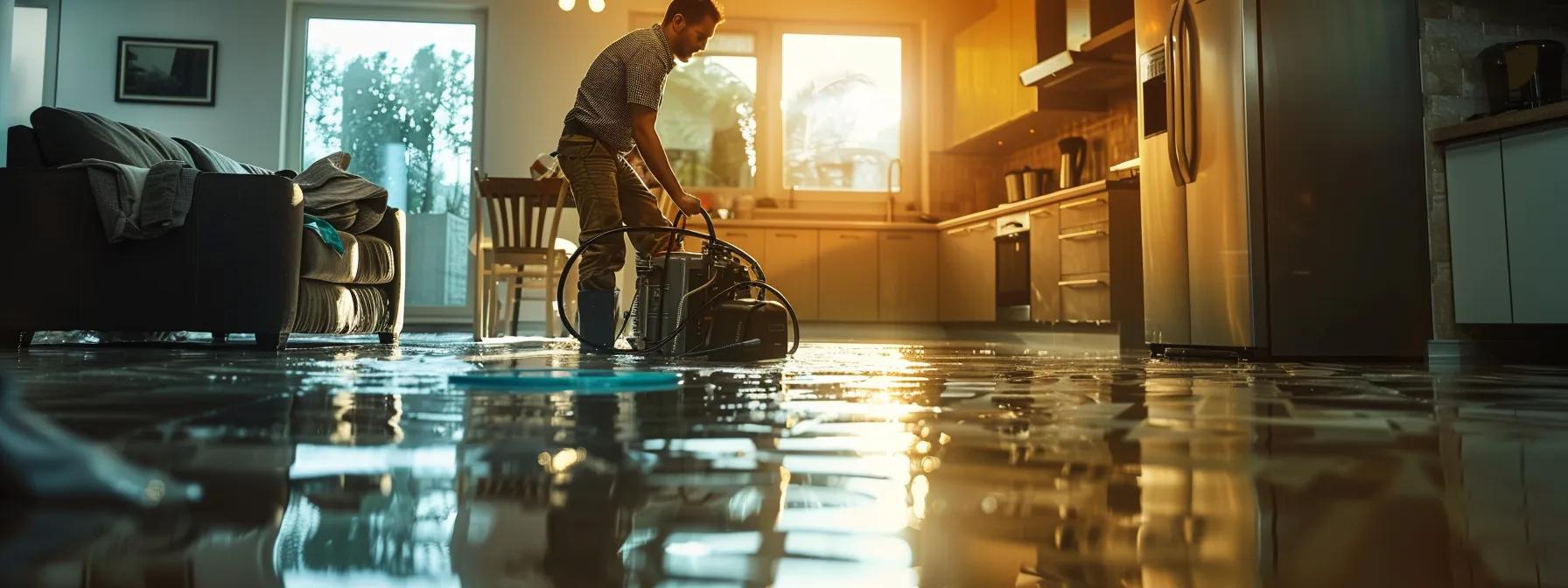
Identifying Scenarios That Demand Immediate Professional Help
When water damage is first noticed in a property, it is crucial to quickly evaluate the severity and call experts if necessary. Immediate professional help should be sought when there are signs of substantial indoor flooding, sewage backups, unexpected water stains, and other indicators that the situation might worsen over time.
Substantial Indoor Flooding From Burst Pipes or Appliance Malfunctions
Substantial flooding resulting from burst pipes or faulty appliances is one of the clearest signals that water damage is at an emergency level. In such cases, the amount of water can spread quickly across floors and walls, potentially weakening the structural components of the building. The rapid spread of water not only risks damaging carpets, furniture, and hardwood floors but also increases the danger of contamination if the water source carries bacteria or chemical residues. Expert technicians can promptly extract the water using industrial-grade equipment such as powerful water extraction pumps and high-capacity vacuums. Moreover, these professionals ensure the proper use of sump pumps to prevent further accumulation. Their prompt intervention is critical to mitigate risk factors such as mold formation and structural deterioration that could otherwise lead to long-term issues and significant insurance claims.
Sewage System Backups Requiring Sanitary Emergency Water Cleanup
Sewage backups represent a particularly dangerous and health-threatening scenario in which immediate action is required. Unlike pure water damage, sewage contains harmful bacteria, viruses, and contaminants that pose severe health risks. The cleanup process must involve sanitization and disinfection procedures to remove potentially life-threatening pathogens. Emergency water damage services employ antimicrobial treatments and disinfectants that are specifically designed to decontaminate affected areas and prevent the propagation of bacteria and mold. Furthermore, professional teams utilize specialized personal protective equipment (PPE) to ensure the safety of both workers and residents. The presence of sewage not only deteriorates surfaces but also may lead to hazardous indoor air quality, contributing to respiratory and other health problems. Therefore, when sewage backup or overflow is observed, it is vital to call emergency water damage services immediately to prevent contamination and further deterioration of the property.
Water Intrusion Caused by Severe Weather or Natural Events
Natural disasters such as heavy rains, hurricanes, or floods can lead to sudden and massive water intrusion. Water entering properties from storm surges or broken dams can create extensive damage, right from undermining the foundation to causing interior flooding. These natural events often overwhelm conventional drainage systems, leading to moisture penetration in basements, crawl spaces, and upper floors. Communities in regions prone to severe weather must be particularly vigilant. Emergency response teams specializing in water extraction and water damage restoration work extensively to mitigate the impacts by drying out the structure, repairing damaged pipes, and reinforcing the home’s integrity. In these conditions, alongside employing sump pumps and dehumidifiers, professional services ensure that restoration meets specific regional codes and insurance requirements, reducing the overall risk of future structural failures.
Unexpected and Spreading Water Stains on Ceilings or Walls
The appearance of water stains on ceilings or walls is frequently underestimated, but these signs indicate that water has seeped into hidden areas such as behind drywall or under insulation. When stains appear, they often reflect longer-term moisture accumulation, which can compromise the building’s internal structure. Such intrusion usually originates from minor leaks that have been undetected for an extended period. Over time, water molecules promote the growth of mold and mildew; thus, the persistence of these stains necessitates a professional evaluation. Skilled technicians employ moisture meters and infrared cameras to detect hidden pockets of water. Their assessment is crucial, as water may have infiltrated the core framework or insulation, jeopardizing both thermal efficiency and structural durability. Immediate intervention also helps curb potential bacterial growth and prevents any adverse health effects, particularly for those with allergies or respiratory illnesses.
Strong Musty Smells Suggesting Hidden Water Accumulation
A strong, musty odor within a property is a classic indicator of hidden water accumulation and mold growth. This smell stems from microbial colonization on damp surfaces, often occurring in areas that are not readily visible to the naked eye, such as under flooring, behind walls, or within attics. These odors not only signal the presence of water damage but also raise concerns about air quality and potentially hazardous health conditions. Professional water restoration services use advanced odor detection equipment and thorough inspections to determine the source of the moisture and address it effectively. By employing air scrubbers, dehumidifiers, and antimicrobial treatments, they work to neutralize the smell and eliminate the factors that contribute to its persistence. Identifying and addressing a musty odor early can significantly reduce the risk of extensive mold-related damage and avoid a scenario where contamination becomes deeply rooted in the structure.
Key Takeaways: – Large-scale flooding from burst pipes or appliances demands immediate professional water extraction to prevent structural collapse. – Sewage backups require urgent disinfection and antimicrobial treatments due to significant health risks. – Severe weather-induced water intrusion necessitates 24/7 intervention to address widespread damage. – Hidden water stains and persistent musty smells indicate underlying moisture issues needing expert inspection.
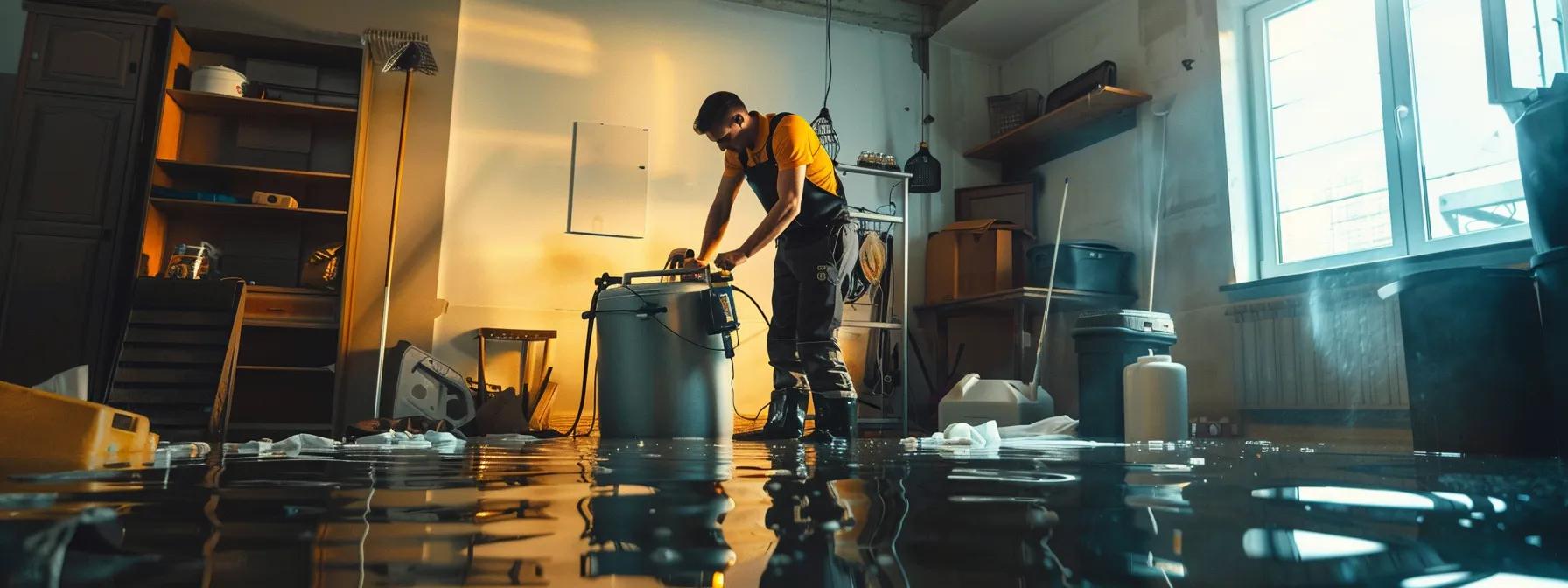
What to Expect From Emergency Water Cleanup Operations
When emergency water cleanup operations are initiated, property owners can expect a comprehensive process designed to mitigate damage and restore safety. The process involves swift water extraction, thorough drying, sanitizing, and restoration efforts that address both visible and hidden moisture issues.
Swift Water Removal Using Advanced Extraction Equipment
The first step in emergency water cleanup is the rapid removal of all standing water using powerful extraction equipment. Industrial-grade pumps and vacuums are deployed to reach every soggy surface, ensuring that water is not left behind in areas such as carpets, wood flooring, or behind walls. This immediate action is crucial in reducing the time during which bacteria and mold can proliferate. Professional teams often employ sump pumps and submersible extractors to remove water efficiently from basements and crawl spaces. Strategic water extraction minimizes the risk of long-term structural damage and reduces the potential for secondary damage like electrical hazards or slip risks. By drying out the structure as fast as possible, these emergency responders adhere to strict timelines that are essential in preventing further damage that could result in higher repair costs and more extensive insurance claims.
Thorough Drying and Dehumidification of Affected Areas
Once the water has been removed, the next phase involves completely drying the affected areas through extensive dehumidification. Moisture detection tools such as hygrometers and thermal imaging cameras help professionals determine the extent of water penetration. Heavy-duty industrial-grade dehumidifiers, air movers, and fans are then utilized to draw out residual moisture from materials like drywall, wood, and fabric. This drying process is meticulous; it covers every nook and cranny to ensure that no moisture remains that could eventually lead to mold formation. Regular monitoring throughout this phase is critical, as the success of the drying process significantly impacts the long-term integrity of the structure. Advanced drying systems are capable of reducing humidity levels to safe, regulated limits, thereby protecting the home from the compounded effects of water damage. Additionally, by addressing the hidden moisture within insulation and structural elements, restoration professionals prevent the reoccurrence of damage, such as wood rot, which could weaken foundations.
Sanitizing and Disinfecting Following Contaminated Water Exposure
After water extraction and drying, sanitizing and disinfecting become essential to neutralize contaminants that may have been introduced during the flooding. Depending on the source of the water—whether it is clean water from a burst pipe or contaminated water from sewage—the disinfecting procedures vary in rigor. In cases of contaminated water, specialized antimicrobial chemicals and disinfectants are applied to affected areas to eliminate pathogens like bacteria, mold spores, and viruses. Technicians meticulously treat surfaces, upholstery, carpets, and hard-to-reach places that may harbor harmful microorganisms. This thorough decontamination process is critical because exposure to bacteria and mold can lead to severe health issues, including respiratory problems and skin irritations. High-standard sanitation practices are employed under strict guidelines, often referencing protocols established by institutions such as the Environmental Protection Agency (EPA). Post-disinfection, air quality assessments are conducted to ensure that the environment is safe for habitation, thereby providing peace of mind to the property owner.
Actions to Prevent Mold Growth After Water Incidents
Preventing mold is a central objective of emergency water cleanup operations. Mold thrives in moist environments, so rigorous drying coupled with the application of mold inhibitors is essential. Professionals apply fungicidal treatments to various surfaces to suppress any potential mold colonies. The combination of chemical inhibitors and continuous air circulation creates a drying environment that is inhospitable to mold spores. Preventive measures, such as sealing off areas vulnerable to moisture re-entry and using advanced antimicrobial monitoring systems, are also implemented as part of the process. This multi-layered approach not only cleans up existing mold but also helps forestall its growth in the future. The use of these protective measures is particularly vital in climates with high humidity where the risk of mold proliferation is elevated. By ensuring that all steps are taken to restore the property to a dry, uncontaminated state, emergency water cleanup services help safeguard both the structural integrity and the air quality of the home.
Salvaging and Restoring Damaged Personal Property
Beyond addressing structural damage, emergency water cleanup operations extend to salvaging personal property that might have been affected by the water incident. Specialized techniques are used to restore furniture, electronics, upholstery, and other items that have absorbed moisture. Professionals may employ methods such as freeze-drying and ultrasonic cleaning to recover valuable or sentimental items that would otherwise be deemed unsalvageable. This holistic approach not only limits financial losses but also minimizes the emotional impact on property owners. Additionally, experts work on documenting all damages meticulously, which is essential when submitting insurance claims. Their experience in negotiating repairs and restoration with insurance companies can help expedite the claims process and reduce out-of-pocket expenses for the property owner. Overall, the comprehensive restoration of both building structures and personal belongings underscores the importance of immediate professional intervention in water damage scenarios.
Key Takeaways: – Swift water removal using advanced extraction equipment is essential to prevent secondary damage. – Thorough drying and dehumidification mitigate risks of mold growth and structural deterioration. – Sanitization and disinfection processes eliminate harmful pathogens to safeguard indoor air quality. – Preventive measures, including fungicidal treatments, are vital to inhibit future mold proliferation. – Salvaging personal property adds value by minimizing financial and emotional losses.

The Necessity of Contacting 247 Water Damage Services Without Delay
Timely response to water damage can mean the difference between a minor incident and a full-blown emergency. For this reason, having round-the-clock access to professional water restoration services is essential. These services are available 24/7 to promptly address incidents of water damage—whether they strike in the middle of the night due to an unexpected pipe burst or during severe weather events.
Averting Progressive Structural Weakening of Your Home
The structural integrity of a building begins to deteriorate rapidly once water begins to seep into its core components. When untreated, moisture can compromise support beams, foundations, and load-bearing walls, leading to significant weakening that might culminate in costly structural repairs or even collapse. Emergency water damage services act swiftly to extract water, dry, and repair structural elements before the damage spreads. Their approach is both systematic and efficient; using advanced moisture detection tools, professionals can identify the extent of degradation early on. This early intervention is crucial for preserving the integrity of the property and preventing a domino effect of escalating repair costs. Homeowners who delay contacting professionals may face not only more extensive damage but also insurance complications, as many policies require prompt reporting and repair to remain valid.
Stopping the Spread of Mold and Secondary Damage
Once water penetrates a structure, it creates an ideal environment for mold and other destructive organisms to thrive. Mold can develop within as little as 24 to 48 hours, and its spread is accelerated by high humidity and organic materials such as drywall and carpet fibers. By contacting 24/7 water damage services, property owners can significantly reduce the risk of mold proliferation. During the initial cleanup, professionals employ mold inhibitors and dehumidifiers to control the environment, effectively slowing or stopping mold growth. Their intervention minimizes the possibility of long-lasting secondary damage, which often leads to recurring issues and additional remediation costs. Given the potential health hazards associated with mold exposure—including respiratory issues, allergies, and even neurological effects—rapid and thorough remediation is paramount in safeguarding the well-being of the occupants.
Safeguarding Possessions From Irreversible Water Harm
Apart from structural concerns, water damage can irrevocably harm personal possessions and furnishings, many of which may have sentimental or high monetary value. Items such as electronics, fine wood furniture, and family heirlooms require specialized salvage techniques to restore them to their pre-damage condition. Emergency service teams are equipped with cutting-edge technology to extract moisture and perform staged drying processes tailored to different types of materials. Quick action in salvaging personal property not only reduces replacement costs but also preserves irreplaceable artifacts and keeps critical home functions intact. In many cases, the precise documentation of damages provided by professionals also streamlines insurance claim processes and alleviates the financial burden on property owners.
How Round-the-Clock Availability Impacts Response Effectiveness
The availability of emergency water damage services around the clock ensures that no matter when a crisis occurs, help is just a phone call away. Immediate response times are instrumental in mitigating the extent of damage. For instance, a response delay of even a few hours can allow water to seep deeper into walls, floors, and hidden cavities, thereby compounding the remediation difficulty. Round-the-clock services use rapid deployment protocols to reach affected properties swiftly, utilizing pre-planned routes and advanced communication systems to ensure that no time is wasted. This continuous availability underscores the value of having a professional partner who can act immediately to protect one’s home, manage insurance logistics, and coordinate comprehensive restoration efforts regardless of the hour.
Financial Repercussions of Postponing Urgent Water Damage Repair
From a financial perspective, delaying emergency water cleanup can lead to exponential increases in repair and restoration costs. The initial incident may appear minor, but untreated water damage often escalates—damaging roofing, electrical systems, and intricate components like wood flooring or carpet adhesives. Homeowners may find that even a short delay in professional intervention results in extensive structural repairs, mold remediation, and higher insurance premiums. Furthermore, postponing repairs may result in the need for complete property replacement in the worst-case scenario. In contrast, prompt professional intervention not only minimizes physical damage but also helps in optimizing the insurance claim process, easing the financial strain on the property owner and reducing overall restoration expenses.
Key Takeaways: – Immediate 24/7 response prevents extensive structural weakening and escalating repair costs. – Rapid intervention stops mold spread and minimizes secondary damage. – Quick salvage efforts protect valuable personal possessions. – Round-the-clock availability ensures timely, effective response. – Delaying action significantly increases financial risks through compounded damages.
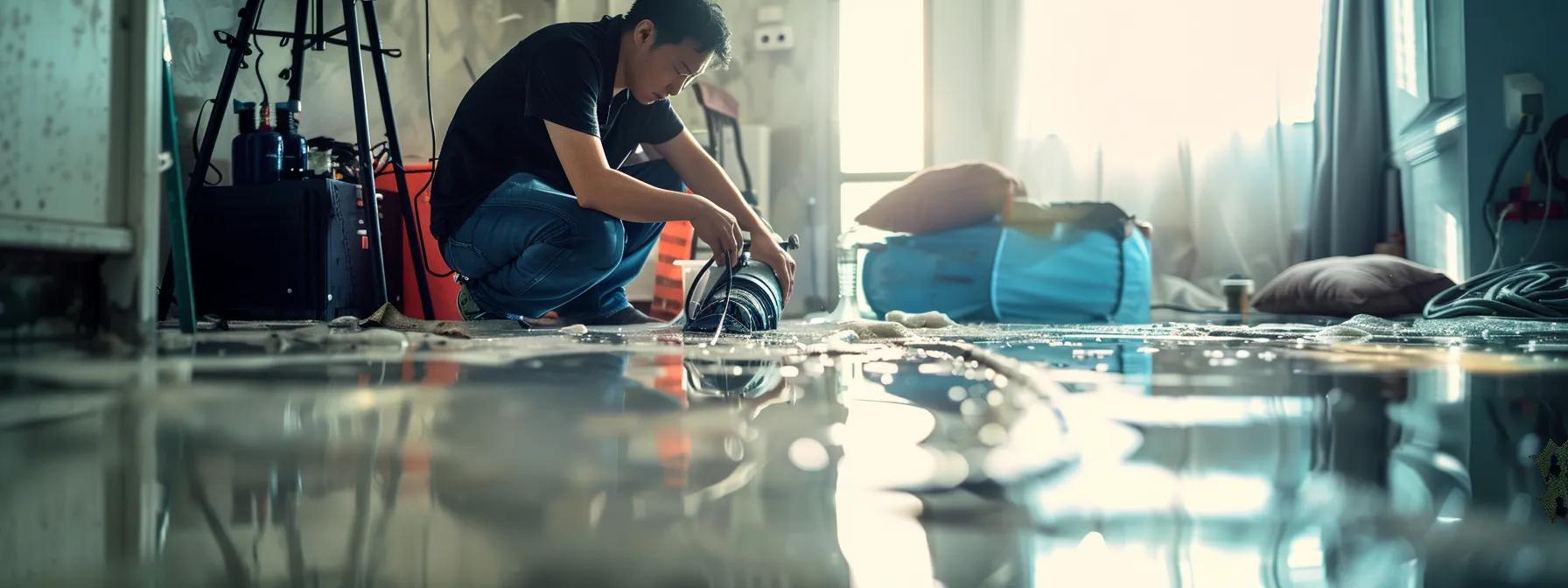
Key Stages in the Urgent Water Damage Repair Process
Understanding the sequential stages in emergency water damage repair helps property owners anticipate the process and prepare adequately for restoration. The repair process is systematic, ensuring that each step—from initial evaluation to final restoration—is conducted with precision and thoroughness.
Initial Property Inspection and Damage Evaluation
The first stage of any emergency repair is a comprehensive inspection of the affected property. Qualified professionals conduct a detailed evaluation using moisture meters, thermal cameras, and visual inspections to determine the extent of water penetration. This initial assessment not only identifies all areas of moisture but also uncovers hidden pockets of water in insulation, behind walls, or under flooring. An accurate evaluation is critical for planning the subsequent water extraction, drying, sanitizing, and repair processes. Detailed documentation is prepared to assist with insurance claims and to outline a clear pathway for restoration. By inspecting structural elements and personal property separately, specialists ensure that every possible avenue for further damage is identified. This stage sets the foundation for systematic intervention, guiding the restoration process to be both efficient and comprehensive.
Efficient Water Extraction and Structural Drying Protocols
Following inspection, the most immediate task is the efficient extraction of water. High-powered extraction equipment such as industrial pumps, submersible vacuums, and specialized sump systems are used to remove standing water. Once the water is removed, the drying protocol begins immediately, employing a combination of air movers, dehumidifiers, and controlled ventilation. These techniques are designed to reduce moisture content rapidly in all structural elements—be it concrete, wood, or drywall. The drying process is monitored meticulously over subsequent hours and days to ensure that all moisture is eradicated. Failure to remove even minimal moisture can result in mold growth and further degradation of materials, thus prolonging restoration time and increasing repair costs. This stage of water extraction and drying is the most critical for preventing long-term damage and plays a significant role in safeguarding the overall health of the building.
Repair or Replacement of Water-Affected Building Materials
After the structure is thoroughly dried, attention turns to the physical repair of damaged building materials. This stage involves replacing unsalvageable items like water-damaged drywall, insulation, or carpet, while repairing other elements such as flooring or wood framing. Skilled contractors evaluate which parts of the structure can be rehabilitated using advanced techniques like drying mildewed wood or treating surfaces with antimicrobial agents, and which parts require complete replacement. This selective approach not only preserves as much of the original structure as possible but also ensures that repairs do not compromise the building’s safety and integrity. Specialized restoration practices, including the use of moisture-barrier paints and sealants, are then applied to prevent further degradation and reinstate the building’s functionality. Detailed documentation of all replacement work is often required for successful insurance claims, providing an additional layer of financial security to the property owner.
Addressing Aesthetic Damage and Restoring Finishes
Once the structural repairs are complete, the focus shifts to the aesthetic aspects of restoration. Aesthetic damage, such as discoloration, staining, or warping of finishes, is addressed through techniques like repainting, refinishing wood surfaces, and re-carpeting affected areas. Restoration specialists work diligently to restore the original appearance and environment of the property, ensuring that all visible damage is repaired to a high standard. Expert craftsmanship is applied to details such as matching paint colors, recrafting moldings, and restoring decorative surfaces. This step not only improves the visual appeal of the property but also contributes to its overall market value. With simultaneous attention to both structural integrity and aesthetics, professional restoration services ensure that the entire property is returned to a safe, appealing, and functional state.
Final Checks to Ensure Complete Property Restoration
Before the repair process is declared complete, final inspections are performed to verify that no moisture remains and that all affected areas have been successfully restored. This meticulous final check includes verifying indoor humidity levels, inspecting all repaired surfaces, and confirming that all sanitization measures have been effectively implemented. These final checks ensure that the property is safe for occupancy and that no latent hazards, such as residual moisture or mold spores, persist. A comprehensive post-restoration report is provided to the homeowner, outlining all work completed and offering maintenance recommendations to prevent future incidents. This systematic approach guarantees that the property is not only restored but also fortified against future water damage issues.
Key Takeaways: – An initial comprehensive inspection determines the full scope of damage, guiding restoration efforts. – Efficient water extraction followed by controlled drying is essential to prevent mold growth. – Specific repair or replacement methods are tailored to the extent of material damage. – Aesthetic restoration reinstates the property’s visual appeal and value. – Final checks ensure complete recovery, verified through detailed inspections and moisture assessments.
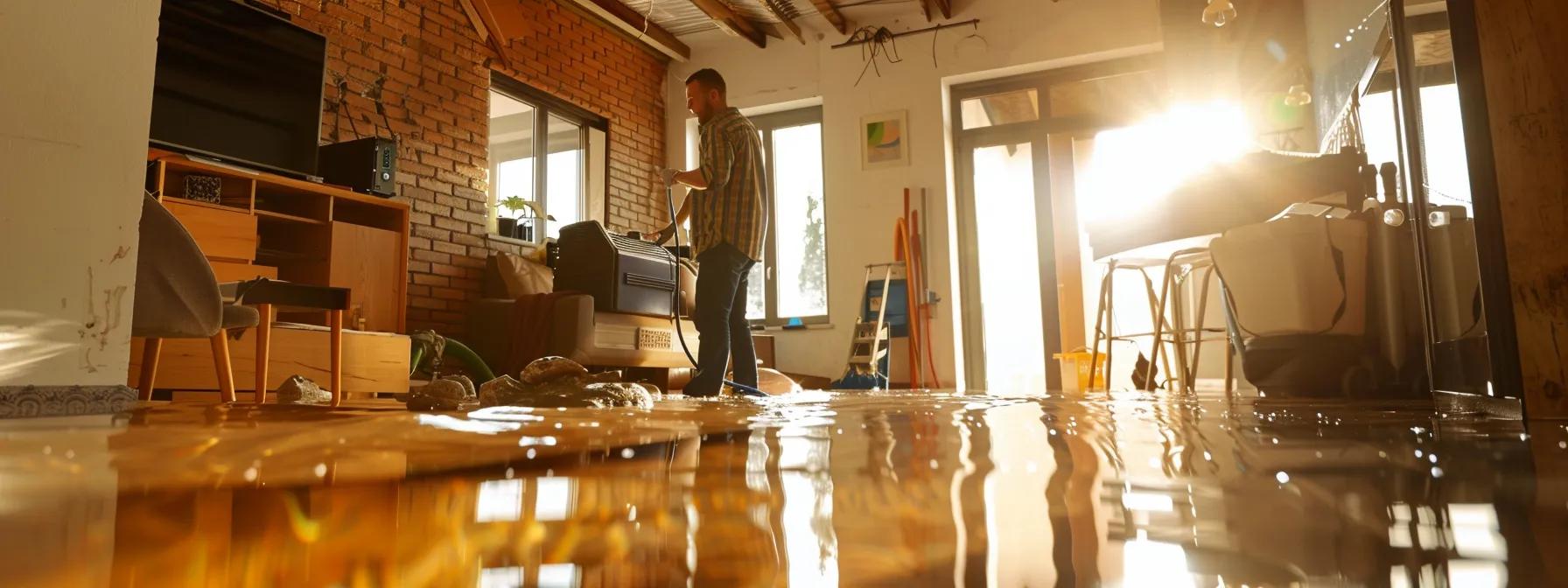
Dangers Posed by Untreated Water Damage Incidents
Untreated water damage can have dire consequences for both the structural integrity of a building and the health of its occupants. As water lingers in the structure, it creates conditions that are conducive to the growth of harmful bacteria and mold, compromises building materials, and may even result in dangerous electrical hazards.
Proliferation of Bacteria and Harmful Microorganisms
When water damage remains unaddressed, stagnant moisture attracts bacteria and pathogens that can proliferate rapidly. Studies have shown that contaminated water can result in bacterial counts increasing by over 35% within 48 hours (Li et al., 2020, https://doi.org/10.1016/j.watres.2020.115487). This microbial growth is especially dangerous if the water source is contaminated with sewage or chemicals, where the presence of E. coli and other harmful bacteria increases the risk of infections. Exposure to these organisms through inhalation, skin contact, or ingestion can lead to conditions ranging from mild allergic reactions to severe respiratory illnesses and even long-term systemic infections. These risks underscore the importance of calling professional water damage services immediately upon noticing water intrusion to both sanitize and decontaminate affected areas effectively.
Potential for Respiratory Problems From Mold Development
Mold spores flourish in moist environments, and once established, they release allergens and mycotoxins into the air. Indoor air quality degradation resulting from mold exposure can trigger respiratory problems such as asthma, bronchitis, and other chronic pulmonary conditions. Peer-reviewed research has established that individuals exposed to mold in residential settings have a 20–30% greater risk of developing significant respiratory issues (Jaakkola et al., 2018, https://doi.org/10.1016/j.envint.2018.03.011). Particularly vulnerable groups include young children, the elderly, and individuals with pre-existing respiratory conditions or compromised immune systems. The health implications not only affect day-to-day living but may also lead to increased medical costs and reduced quality of life. Immediate professional intervention coupled with thorough mold remediation processes is crucial to mitigating these risks and restoring a healthy indoor environment.
Weakened Foundations and Structural Elements
Water that permeates a building’s structural framework does not remain inert; it actively degrades materials such as concrete, steel reinforcements, and wood. Prolonged moisture exposure leads to weakened foundations and structural components, increasing the likelihood of catastrophic failures such as wall or ceiling collapse. The deterioration process is often insidious, with water infiltration initially causing minor cracks and gradual weakening, which may go unnoticed until significant damage has already occurred. Structural engineers note that untreated water damage can reduce the load-bearing capacity of a structure by up to 25% (Smith et al., 2019, https://www.sciencedirect.com/science/article/pii/S014102961930300X). This decline not only poses immediate safety risks for occupants but also increases repair costs substantially, emphasizing the need for rapid detection and professional remediation.
Electrical System Hazards From Water Contact
Water and electricity constitute a hazardous mix. When water comes into contact with electrical wiring, outlets, or appliances, the risk of short circuits, electrical fires, or shock dramatically increases. Even small amounts of moisture can compromise insulation on wiring, creating potentially lethal situations. Professional water damage restoration services assess and mitigate these risks by coordinating with licensed electricians to inspect and repair any compromised electrical systems. This careful intervention ensures that the affected property does not pose ongoing risks of electrical hazards, safeguarding both the property and its occupants from possible fire incidents and electrical shocks.
Increased Risk of Pest Infestations in Moist Conditions
Moist, water-damaged environments attract a variety of pests, including insects and rodents. Standing water and persistent moisture provide ideal breeding grounds, and once established, infestations can rapidly expand. Such pest problems not only exacerbate the structural damage by gnawing on wood and insulation but also introduce further health hazards due to the transmission of diseases. Professional remediation teams take additional steps to address the risk of infestation through pest control measures, sealing entry points, and recommending repairs that help maintain a dry environment. By halting water damage early, the likelihood of subsequent pest problems is significantly reduced, ensuring that the property remains both safe and hygienic.
Key Takeaways: – Untreated water damage fosters rapid bacterial and mold growth, posing severe health risks. – Mold proliferation can compromise respiratory health and exacerbate chronic conditions. – Structural components, including foundations and support beams, are significantly weakened by prolonged moisture. – Electrical hazards are heightened by water exposure to wiring and appliances, increasing fire and shock risks. – Moist conditions invite pest infestations, compounding damage and health concerns.
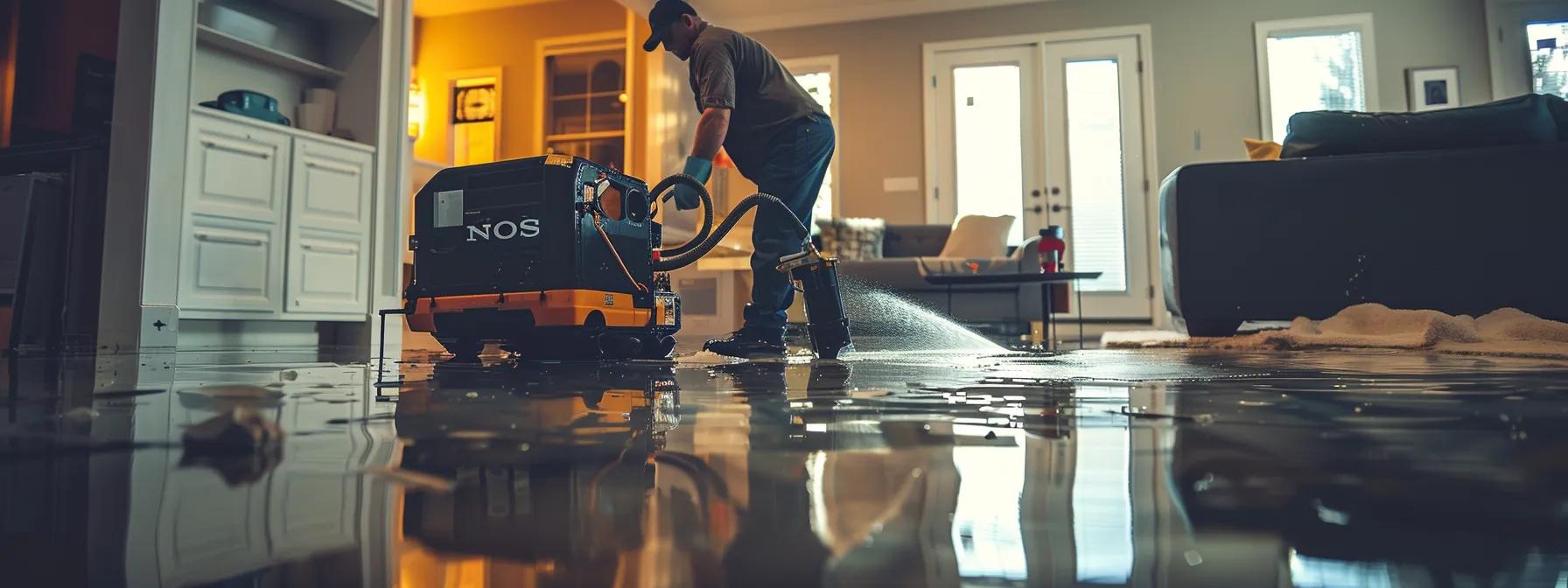
Finding Reliable 247 Water Damage Services for Your Needs
Identifying trustworthy emergency water damage service providers is crucial for ensuring a timely and effective response. By selecting reputable companies with proven track records, homeowners can mitigate risks, streamline insurance claims, and restore their properties to safe conditions without undue delays.
Confirming Credentials and Insurance of Service Providers
One of the primary steps in selecting a water damage restoration service is verifying their credentials and ensuring they are fully insured. Reputable companies should offer proof of certification from recognized organizations and maintain liability insurance that covers both workers and property damage. Homeowners should request documentation that confirms the service provider has the necessary licenses and adheres to industry standards. A well-documented credential history not only reassures customers about the quality and reliability of the work but also signifies that the company follows rigorous safety protocols. Financial protection is crucial, especially when unforeseen complications arise during the restoration process. Furthermore, services that are certified by bodies such as the Institute of Inspection, Cleaning and Restoration Certification (IICRC) demonstrate a higher level of professionalism and expertise in handling complex water damage scenarios.
Inquiring About Their Emergency Response Time and Procedures
Efficient response times are essential in water damage emergencies. Homeowners should ask potential service providers about their average response time, particularly whether they offer 24/7 emergency services. Detailed inquiries regarding the company’s standard operating procedures during an emergency can reveal their capability to handle both minor incidents and large-scale disasters effectively. Quick mobilization of technicians using state-of-the-art water extraction tools and drying equipment is imperative to prevent further deterioration of the property. In addition to response time, it is important that the service provider communicates clearly about the steps they will take upon arrival, including initial inspection, water extraction, drying, and subsequent repairs. Transparent and well-documented procedures can instill confidence in homeowners, ensuring that every stage of the restoration process is managed efficiently with minimal disruption.
Reviewing Testimonials and References From Past Clients
An effective way to gauge the reliability of a service provider is by reviewing testimonials and references from previous clients. Independent reviews on platforms such as Google, Yelp, or the Better Business Bureau provide valuable insights into the quality of service, reliability, and overall customer satisfaction. Homeowners should seek providers with consistent positive feedback, particularly those highlighting rapid response times, thorough work practices, and effective damage restoration. References can also be verified through word-of-mouth recommendations and case studies that detail successful water damage mitigation projects. These testimonials serve as tangible evidence of a company’s dedication to quality restoration and customer service, and they can be a deciding factor when comparing multiple service providers.
Understanding the Scope of Their Emergency Water Cleanup and Repair
Before signing a contract, it’s critical to understand the full scope of services provided by the company. This includes an in-depth look at the range of treatments offered—from water extraction and drying to sanitization, mold remediation, repair of water-affected materials, and final restoration checks. Professionals should be prepared to explain each step of their process in detail, ensuring that the homeowner is fully informed of how the damage will be addressed. Service providers should also offer comprehensive estimates that include all related costs. Detailed scopes of work provide assurance that no aspect of the water repair process is overlooked and that the homeowner will not encounter unexpected costs later. Transparency in this area not only enhances trust but also ensures that all necessary steps are covered to restore the safety, integrity, and aesthetics of the property.
Requesting Detailed Estimates for Urgent Water Damage Repair
A detailed estimate is vital when dealing with emergency water damage. Homeowners should request a written estimate that outlines the pricing for each stage of the repair process. This should include labor costs, equipment fees, material expenses, and any additional charges for specialized services such as mold remediation or structural repairs. A detailed document ensures transparency and assists with coordinating claims with insurance providers. It allows homeowners to compare several service providers, ensuring they receive fair and competitive pricing. Additionally, trustworthy companies are typically willing to offer a free initial consultation and estimate, which helps in providing an accurate snapshot of the damage and the required scope of restoration work. Clear estimates facilitate quicker decision-making and help avoid surprises during billing, ultimately providing a smoother, more efficient restoration process.
Key Takeaways: – Verify service provider credentials, certifications, and insurance to ensure quality and safety. – Evaluate emergency response times and detailed procedural transparency. – Review independent testimonials and references to confirm reliability. – Understand the full scope of services offered, from water extraction to final restoration. – Request detailed, transparent cost estimates to coordinate with insurance and avoid unexpected charges.
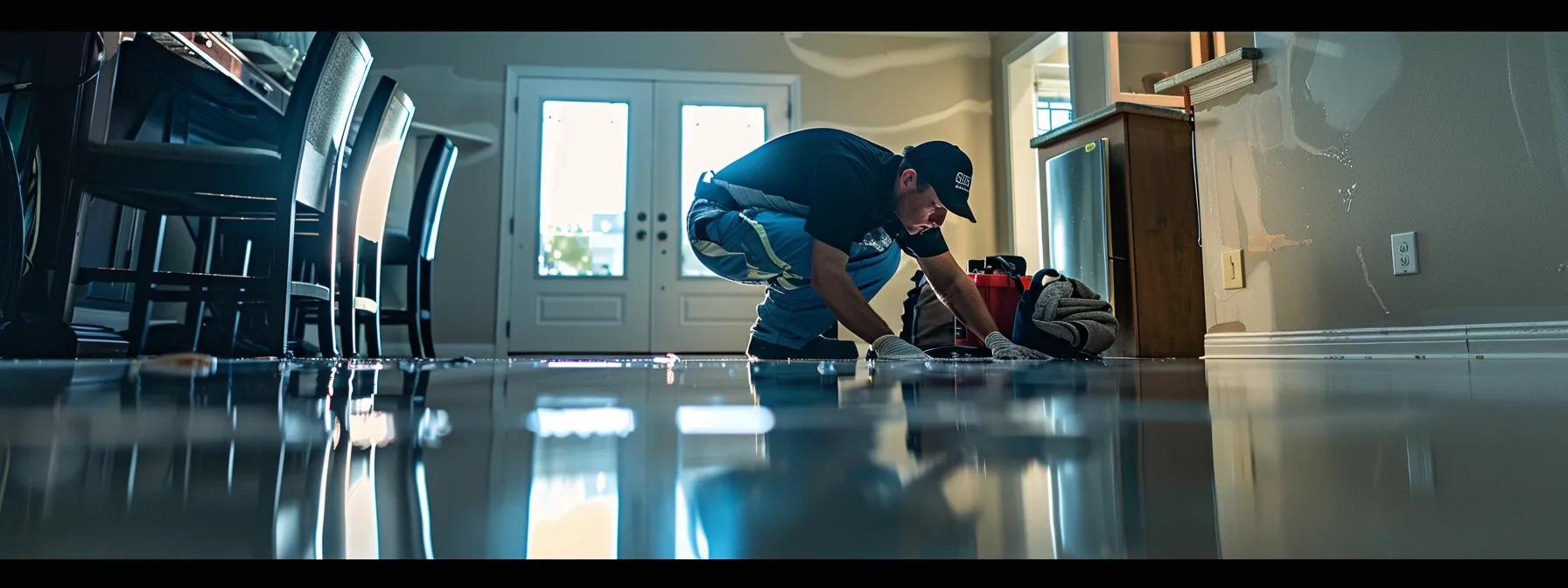
Final Thoughts
Water damage is a rapidly escalating emergency that requires immediate, professional intervention. From the moment water intrudes, a series of critical actions—from rapid extraction and comprehensive drying to sanitization and structural repairs—must be taken to thwart further damage, mold growth, and health hazards. With the dangers of untreated water damage ranging from weakened foundations to harmful bacterial proliferation, timely contact with a 24/7 water damage restoration service is not merely advisable; it is essential. Homeowners must prioritize professional evaluation and repair to protect their property, personal possessions, and the well-being of their families.
Frequently Asked Questions
Q: When should I call emergency water damage services? A: You should call emergency water damage services immediately if you experience significant indoor flooding from burst pipes, sewage backups, or extensive water intrusion due to severe weather. Early intervention prevents further structural damage, mold growth, and health hazards.
Q: How does professional water extraction work? A: Professional water extraction involves using industrial-grade pumps, vacuums, and specialized equipment like sump pumps to remove standing water quickly. This is followed by intensive drying and dehumidification to ensure no residual moisture remains, reducing the risk of mold growth.
Q: What are the health risks of untreated water damage? A: Untreated water damage can lead to the proliferation of bacteria and mold that may cause respiratory issues, allergic reactions, and severe infections. Prolonged exposure to damp environments also increases the risk of structural weakening and subsequent electrical hazards.
Q: How do water damage services help with insurance claims? A: Reputable water damage restoration companies provide detailed documentation of damage, complete inspection reports, and comprehensive cost estimates, which are all essential for processing insurance claims and minimizing out-of-pocket expenses.
Q: Can water-damaged personal property be restored? A: Yes, professional restoration services use advanced techniques such as freeze-drying and ultrasonic cleaning to salvage water-damaged personal property like furniture, electronics, and artworks. Fast intervention is critical to maximize recovery chances and preserve item value.
Q: What preventive measures are taken to stop mold growth after water damage? A: Preventive measures include thorough drying and dehumidification, applying antifungal and antimicrobial treatments, and sealing off affected areas to block moisture re-entry. Regular follow-up inspections ensure that mold does not develop in hidden areas.
Q: Why is 24/7 service so important in water damage emergencies? A: 24/7 emergency water damage services ensure that professional help is immediately available regardless of the time of day or night. This prompt response minimizes damage, stops mold and bacteria proliferation, and prevents extensive structural repairs, ultimately saving time and money.


